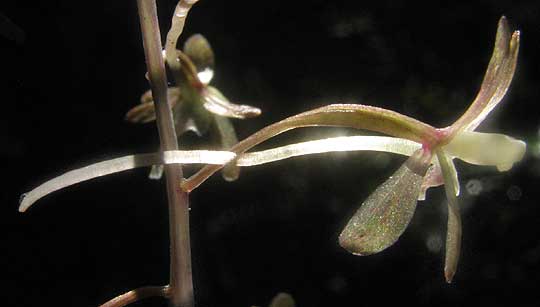Excerpts from Jim Conrad's
Naturalist Newsletter
from the August 12, 2012 Newsletter issued from the woods of the Loess Hill Region a few miles east of Natchez, Mississippi, USA
CRANEFLY ORCHID
Deep in a forested, heavily shaded, rich-soiled ravine bottom I almost stepped on an orchid's slender, knee high flower cluster not only because it was so shadowy there but also because the inflorescence was so inconspicuous. You can see a flash-enhanced picture of it below:

A close-up of a single inch-long (2.5cm), pale, greenish-purple flower is shown below:

The most distinctive, easily seen feature of that blossom is its extremely long "spur" -- the slender, white item cutting horizontally across the picture. The idea behind such a long spur is that moths insert their long, strawlike proboscises into the spur to get at nectar at the spur's opposite tip, in the process pollinating the flower. A study on this species found that it is pollinated by noctuid moths, who usually are dull colored, night-flying species.
This is the Cranefly Orchid, TIPULARIA DISCOLOR, restricted to the Southeastern US except for Florida, and extending north to New York and southern Illinois. Its habitat is mainly humus-rich soil of deciduous woodlands exactly like what we have here on the lower slopes of our wooded ravines. Elsewhere Craneflies are often found in sandy, acid soils of oak-pine woods. They seem to have a special affinity for depressions under Sweetgum trees.
In our first picture you might have noticed that the flower cluster arose directly from the soil with no leaf in evidence anywhere. In late fall long after these flowers and their spindly stalks have faded the plant's underground corm will issue an evergreen leaf that is dark green above and dark purple below. Over the winter the leaf will photosynthesize and provide energy to the root. Then late the next spring the leaf will have disappeared and in mid-summer you'll get what you see here.
In orchids, pollen is produced in tiny packets called pollinaria. Flowers use special tricks to get the pollinaria stuck to their pollinators who then carry the pollinaria to the next flower and leave it on the female part. Cranefly Orchids are adapted so that when their noctuid moth calls, inserting its proboscis into the deep spur, pollinaria are attached to one of the moth's compound eyes.